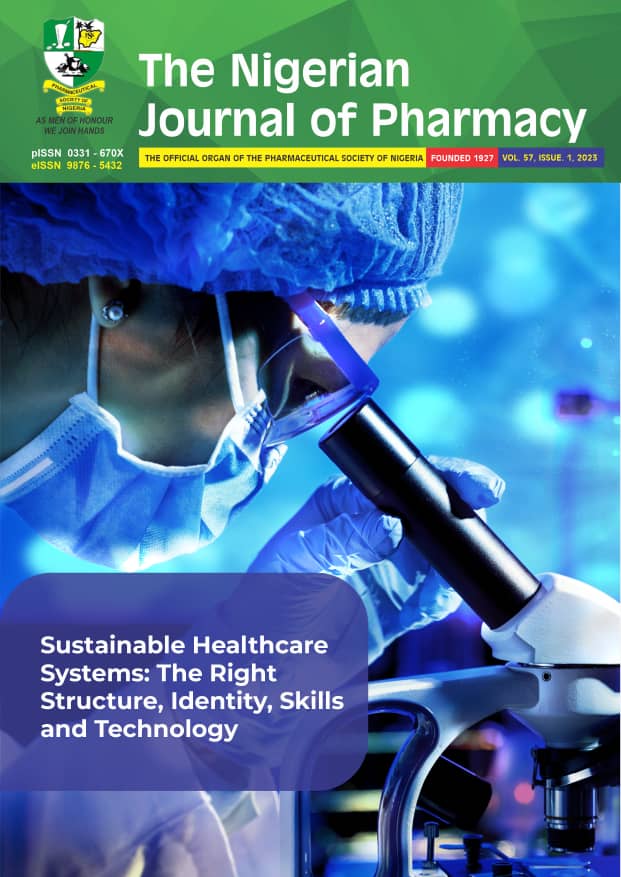Willingness to Pay for Medicines used in the Management of Hypertension and Diabetes Mellitus in Plateau State, Nigeria.
https://doi.org/10.51412/psnnjp.2023.8
Keywords:
Access to medicines, Diabetes, Hypertension, Willingness to pay, Health Valuation method.Abstract
Background: Due to poverty, in low- and middle-income countries the increase in cost leading to unwillingness to pay for life long treatment of most chronic diseases like hypertension and diabetes in Nigeria is always on the increase resulting to increase in morbidity and mortality. To fifind out the solution, the willingness to pay for essential medicines by hypertensive and diabetic patients in Jos and environs in 2019 was used as a tool.
Method: A cross sectional descriptive study using the health valuation method with the 5 dimension 3 level version of European Quality of Life 5 Dimensions 3 Level Version EQ-5D (EQ-5D-3L) is a generic tool for Patient Reported Outcomes (PRO) measurement that can assess patients' quality of life, irrespective of the disease introduced in 1990 by the European quality of life (EuroQol) group questionnaire was adopted the fifive dimensions namely: Mobility, Self-care, Usual activities, Pain / discomfort, and Anxiety / depression while the 3 Levels include: No problems/ pain/ anxiety, Some problems/ pain/ anxiety, and Extreme problems/ pain/anxiety.
Results: Out of the 360 respondents of which majority were females 192 (53.3%), respondents aged 55 years were in majority 303 (84.2%). Those with hypertension were higher 257 (71.40%) than those with diabetes and those with both diseases. Majority of the respondents earn between NGN61,000 to NGN140,000 23 (64.5%) while only 5 (1.4%) of them earn NGN181,000 and above.
Conclusion: Most of the respondents (75.4%) where willing to pay between NGN3,000.00 and less for their treatment while only a few (1.2%) where willing to pay NGN15,000.00 and above. Over 70% of the respondents indicated no problems with mobility, self-care, carrying out usual activities, and anxiety/depression while 98.2% had no problems of taking care of themselves. There was signifificant relationship between gender and anxiety/depression (P-0.001). Married respondents reported problems with mobility more than others (P=0.0001). Those who earn between NGN61,000 and NGN100,000 signifificantly did not have any problems with mobility (P=0.0001) and self-care (P=0.031) respectively compared to other income categories.
References
World Bank. Nigeria economic report: Improved economic outlook in 2014 and prospect for continued growth looks good 2014. Accessed 3 November 2016
World Health Organization. Global status reports on noncommunicable diseases 2014. Accessed 3 November 2016.
World Health Organization. Non-communicable diseases progress monitor 2015.Accessed 6 November 2016.
International Diabetes Federation. IDF Diabetes Atlas, (cited 2018, 25th March); Available from http://www.diabetesatlas.org/
International Diabetes Federation. IDF Diabetes Atlas -7th edition, Brussel, Belgium. International Diabetes Federation. 2015.
Uzochukwu BSC, Ughasoro MD, EƟaba E, Okwuosa C, Envuladu E, Onwujekwe OE (2015) Health care financing in Nigeria: Implications for achieving universal health coverage. Niger J Clin Pract 18(4):437-44.
Oyekale AS (2012) Factors influencing household willingness to pay for National Health insurances Scheme (NHIS) in Osun State, Nigeria Ethno meet 6(3): 167-172
Abodunrin O, Adeniran T, Adebimpe W, Alagbe O, Sabageh A, Adeomi A(2017) Willingness to pay for Management of hypertension Among Patients in a Southwestern City of Nigeria, International Journal of General Medicine, and Pharmacy 6(5); 2319-3999
Ayodele OE, Alebiosu CO, Salako BL (2005). Target organ damage and associated clinical conditions among Nige ri ans with tr e a t ed
hypertension. Cardiovasc J S Afr 16:89-93
Alozie NO, Catherine MCN (2009) Poverty status and willingness to pay for local public services. Public Admin Quar. 33(4): 520-551.
Temitope TS, Lornumbe U, Mercy I, Amina M,Janefrances UO, Amusa GA (2021) Prevalence of Hypertension and Assessment of its Risk Factors among Traders in Rukuba-Road Satellite Market in Jos, North Central Nigeria. Nigerian journal of medicine: journal of the National Association of Resident Doctors of Nigeria IP: 10.232.74.22
Ayodele OE, Adebiosu CO, Salako BL (2005) Target organ damage and associated clinical conditions among Nigerians with treated
hypertension. Cardiovasc J S Afr; 16:89-93
Dangiwa A, Timothy O, Steven S (2022) Affordability of Anti-hypertensive and Anti- hypertensive co-morbid with diabetes in Jos and
environs, Central Nigeria. GSC Biological and Pharmaceutical Sciences, 21(02), 105–111
Woelfel A, Carr-lopez S, Delos S, Bui A, Patel R, Walberg M (2014) Assessing Medicare beneficiaries' willingness-to-pay for medication therapy management services. Pub Med.; 29(2):104-9.
Mengyang D, Chen M, Zuyao Y, Hong D, Qu L, Shuiming L (2020) Lack of effects of evidence-based, individualized counseling on medication use in insured patient with mild hypertension in China: a randomized controlled trial. BMJ 25:102-108.
Raymond M, Helen-Maria V, Samantha G, Djamal B (2017) Out–of-pocket costs and adherence to antihypertensive agents among older adults covered by the public drug insurance plan in Quebec. Dove Press Journal 11: 1513-1522.
Chang K. (2010) Comorbidities, Quality of Life and Patients' willingness to pay for a cure for Type 2 diabetes in Taiwan, Elsevier Public Health, 124(5):284-294.
Jendle J, Torffvit O, Ridderstrale M (2010) Willingness to pay for health improvements associated with anti-diabetes treatments for people with type 2 diabetes. Curr Med Res Opin 26:917–23
Etienne A, Ben D, Marie H, Joseph S, Joel L(2019) Willingness to pay for medical treatments in chronic disease: a multi-country survey of patients and physicians. Journal of comparative Effectiveness Research 8(5), 357–369.
Antonio R (2015) Patients and Professionals Preferences for Type ADiabetes Mellitus Treatment in Spain and Portugal: Willingness to Pay for Gaining Health Benefits and Avoiding Side Effects, AES Journal.
Views | PDF Downloads:
545
/ 255
/ 0
Published
How to Cite
Issue
Section
License
Copyright (c) 2023 The Nigerian Journal of Pharmacy

This work is licensed under a Creative Commons Attribution-NonCommercial 4.0 International License.



